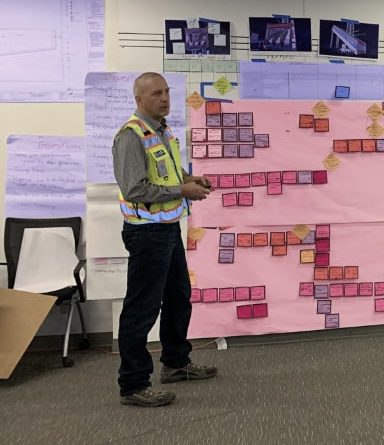How to Lead a Pull Plan Session
Around 15% of builders are using Pull Planning (although only 9% are using the full Last
Planner® System) on at least some of their projects, according to the AGC and McGraw
Hill. The challenge is how to get the most value in the shortest time during a pull
planning session.
The authors of this blog have led and coached over 200 pull planning sessions in the last
few years, co-authored a book on the subject, and led dozens of training sessions and
webinars. We’ve seen it done right, done wrong and learned from our mistakes and
those of others. We’ve refined the leadership needs for pull planning and can say with
confidence that leading a pull planning session takes “PEN”:
- Preparation
- Enthusiasm
- Neutrality
Of course, you need to know construction, the concept of pull, the sequence of the
backward pass and forward pass, how to jumpstart a team of trade foremen to “get
them to the wall” and how to pull in the General Contractor/Design Builder (“GC/DB”)
leadership resources and commitment. But for now, let’s focus on the “magic” of
getting a group of 10-20 trade foremen – each with his/her own personality, experience,
attitudes and needs – actively to collaborate in the pull planning session.
1- Preparation. It starts with preparation – yours and theirs. Everyone involved needs that “aha” moment when they realize that organized collaborative pull planning kicks butt compared to the “lone genius” most projects using P6 have. They’ve probably heard the statistics: 4-20 weeks saved on the schedule, doing 5 months worth of work in 3 months, doubling production in 6 weeks from $1.5 Million/Day to $3.0 Million/Day, and so on. However, it’s not real till you feel it. We recommend the team spend 3-4 hours doing the Villego™ simulation. Until you’ve experienced it yourself, you simply don’t understand the brilliance of “pull”. For the session leader, it means preparing the materials to be used – post-its, Sharpies, plotter paper, flip chart, painters tape, laminated site plans or floor plans (elevations for skin), RFI logs, submittal logs, having the BIM model running, etc. It also means pulling the leadership team together and selecting in advance key milestones to be pulled with their target dates.
2- Enthusiasm. Once the session begins you must keep a steady and somewhat quickened/urgent pace to keep everyone’s attention and focus. The leader needs to be enthusiastic, both about the process and about the ability of each individual to contribute his/her unique skill, experience and knowledge to the team planning. Set time expectations: “Ok, let’s get our tags up in 30 minutes, if you need help I’ve got 2 hands.” Cheerlead: “Great job, Frank! Come on, Greg, get those 3 tags up there before you write any more, the team needs your input
on the wall.” Broker conversations. Listen for what we call “the hum” that occurs as the session hits its stride: the sound of multiple conversations about specific project elements or approaches. It’s not too loud, not too soft, and sounds like a wavy hum. Move around the room helping, encouraging, asking things like, “What else has to be in place to release this work?” and then make sure tags keep moving to the wall. Keep time, nudge, urge, “Ok we need to get to the next step, you’ve got 5 more minutes. You can do it!” Look, not everyone is that enthusiastic in real life. We know that. But a pull plan session is a “stage” and the leader has to play the part, so if you’re typically more reserved, think of it as an acting assignment. Play the role. Step it up. Use your voice, your body and your movements to keep the planning focused and moving rapidly.
3- Neutrality. Why does the leader need to be neutral? Because the old paradigm of construction (which is 85% of the projects the trades are on) is top down command and control. There is no voice for “subs” and they aren’t allowed to say “no”. They may be expecting to get steamrolled by the GC/DBer. The trades are thinking: “Sure you want my input now, but in the end you’re going to tell us what to do, and we had better do it.” However, to work effectively pull planning needs a true collaborative team that trusts each other to tell it straight, give real
durations (no hidden float) and make reliable promises and keep them. To get that kind of team spirit and collaboration, the leader must be neutral. It’s easy for us coaches to be neutral. We work for what is best for the project, aka “Project First” . The leader needs to explain at the beginning of the session, “We want your honest input today. Sure we’ve thought through this and have a plan for how it could go, we wouldn’t have gotten this project without it. But that plan can always be improved with your experience and your input. So we’re going to figure this out together. And I’m going to stay neutral on what the better way to build this is until we’ve talked through the options, gamed them with our tags, and decided as a group what way will work to everyone’s advantage.” And as leader, if you can’t resist and you need to step out of your neutral role and advocate for one position, then hand the PEN to someone else to serve as the neutral leader for a few minutes. When you’ve advocated for your position, announce you’re taking the PEN back and now will be neutral again. If you do this, you will enhance your leadership authority and build more trust from the team.

